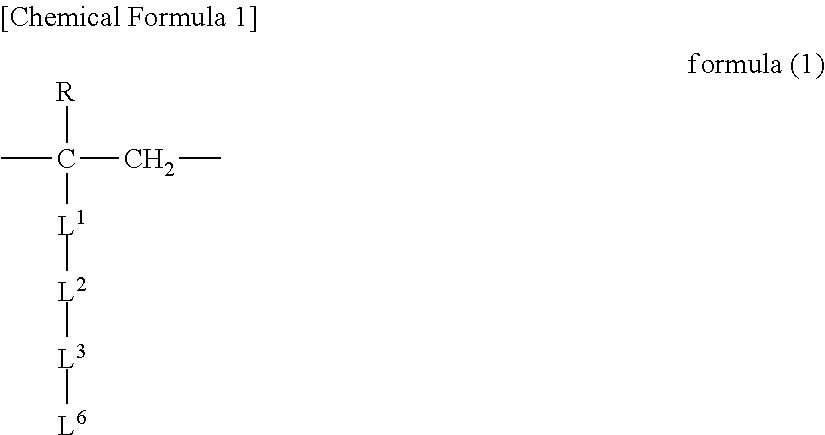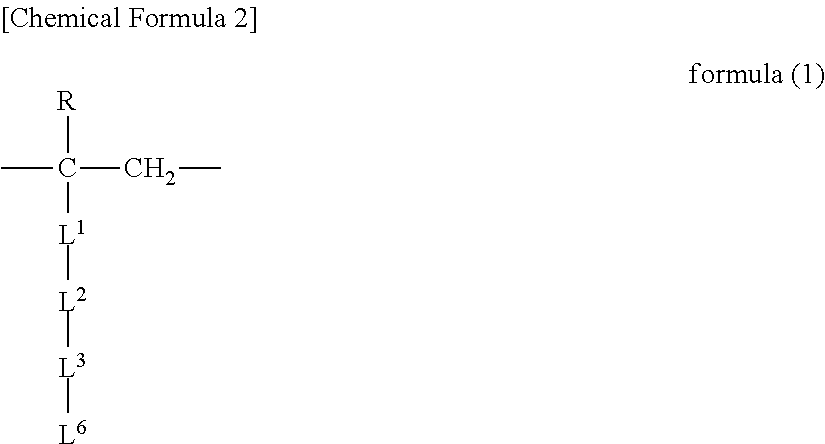Resin composition and use thereof
a technology of resin composition and resin layer, applied in the direction of synthetic resin layered products, electrical equipment, domestic applications, etc., can solve the problems of suppression of temperature elevation in electronic devices or electronic parts, significant increase in heat generation, etc., and achieve the effect of suppressing temperature elevation
- Summary
- Abstract
- Description
- Claims
- Application Information
AI Technical Summary
Benefits of technology
Problems solved by technology
Method used
Image
Examples
reference example 1
(1) Production of Polymer Consisting of Constitutional Unit (A), Constitutional Unit (B), and Constitutional Unit (C) (Ethylene-n-Docosyl Acrylate-n-Eicosyl Acrylate-n-Octadecyl Acrylate-Methyl Acrylate Copolymer)
[0355]The inside of a reactor equipped with a stirrer was purged with nitrogen, and then A-1:100 parts by weight, B-1: 97.4 parts by weight, and C-1: 2.1 parts by weight were added, and heated and stirred with the jacket temperature set at 140° C. under a reduced pressure of 1 kPa for 12 hours to afford a polymer (cf1) (ethylene-n-docosyl acrylate-n-eicosyl acrylate-n-octadecyl acrylate-methyl acrylate copolymer). Physical property values and evaluation results for the polymer (cf1) are shown in Table 1.
reference example 2
(1) Preparation of Crosslinked Resin Composition (Crosslinked Resin Composition Containing Ethylene-n-Docosyl Acrylate-n-Eicosyl Acrylate-n-Octadecyl Acrylate-Methyl Acrylate Copolymer and Polypropylene)
[0356]The polymer (cf1) obtained in Reference Example 1(1): 80 parts by weight, D-1: 20 parts by weight, E-1: 1.0 part by weight, F-1: 1.0 part by weight, G-1: 0.1 parts by weight, and H-1: 0.1 parts by weight were extruded by using the twin-screw extruder (1) with a screw rotation frequency of 350 rpm, discharge rate of 200 kg / hr, first-half barrel temperature of 200° C., second-half barrel temperature of 220° C., and die temperature of 200° C. to prepare a crosslinked resin composition (cf2).
reference example 3
(1) Production of Polymer Consisting of Constitutional Unit (A) and Constitutional Unit (B) (Ethylene-α-Olefin Copolymer)
[0357]An autoclave having an inner volume of 5 L and equipped with a stirrer was dried under reduced pressure and the inside was then purged with nitrogen, into which 1.4 L of toluene solution containing 706 g of α-olefin C2024 (mixture of C18, C20, C22, C24, and C26 olefins, produced by INEOS) was added, and then toluene was added thereto to a liquid volume of 3 L. The autoclave was warmed to 60° C., and ethylene was then added until the partial pressure reached 0.1 MPa to stabilize the inside of the system. Hexane solution of triisobutylaluminum (0.34 mol / L, 14.7 ml) was loaded therein. Subsequently, toluene solution of dimethylanilinium tetrakis(pentafluorophenyl)borate (1.0 mmol / 13.4 mL) and toluene solution of diphenylmethylene(cyclopentadienyl)(fluorenyl)zirconium dichloride (0.2 mmol / L, 7.5 mL) were loaded therein to initiate polymerization, and ethylene ga...
PUM
| Property | Measurement | Unit |
|---|---|---|
| enthalpy of fusion | aaaaa | aaaaa |
| temperature | aaaaa | aaaaa |
| temperature | aaaaa | aaaaa |
Abstract
Description
Claims
Application Information
 Login to View More
Login to View More - R&D
- Intellectual Property
- Life Sciences
- Materials
- Tech Scout
- Unparalleled Data Quality
- Higher Quality Content
- 60% Fewer Hallucinations
Browse by: Latest US Patents, China's latest patents, Technical Efficacy Thesaurus, Application Domain, Technology Topic, Popular Technical Reports.
© 2025 PatSnap. All rights reserved.Legal|Privacy policy|Modern Slavery Act Transparency Statement|Sitemap|About US| Contact US: help@patsnap.com



